CC and C Technologies WL1102 WLAN Cardbus PCMCIA Card User Manual UserManual
CC&C; Technologies, Inc. WLAN Cardbus PCMCIA Card UserManual
Manual
1
IEEE802.11b
Wireless LAN Adapter
User Manual
Version 1.0
2003/2/20
2
FCC INFORMATION
Federal Communication Commission Interference Statement
This equipment has been tested and found to comply with the limits for a Class B
digital device, pursuant to Part 15 of the FCC Rules. These limits are designed to
provide reasonable protection against harmful interference in a residential installation.
This equipment generates, uses and can radiate radio frequency energy and, if not
installed and used in accordance with the instructions, may cause harmful
interference to radio communications. However, there is no guarantee that
interference will not occur in a particular installation. If this equipment does cause
harmful interference to radio or television reception, which can be determined by
turning the equipment off and on, the user is encouraged to try to correct the
interference by one of the following measures:
- Reorient or relocate the receiving antenna.
- Increase the separation between the equipment and receiver.
- Connect the equipment into an outlet on a circuit different from that
to which the receiver is connected.
- Consult the dealer or an experienced radio/TV technician for help.
FCC Caution: Any changes or modifications not expressly approved by the party
responsible for compliance could void the user's authority to operate this equipment.
This device complies with Part 15 of the FCC Rules. Operation is subject to the
following two conditions: (1) This device may not cause harmful interference, and (2)
this device must accept any interference received, including interference that may
cause undesired operation.
IMPORTANT NOTE:
FCC Radiation Exposure Statement:
This equipment complies with FCC radiation exposure limits set forth for an uncontrolled
environment.
This transmitter must not be co-located or operating in conjunction with any other
antenna or transmitter.

3
REGULATORY INFORMATION
The Wireless LAN PC Card must be installed and used in strict accordance with the
manufacturer’s instructions. This device complies with the following radio frequency
and safety standards.
USA - Federal Communications Commission (FCC)
This device complies with Part 15 of FCC Rules. Operation is subject to the following
two conditions:
1. This device may not cause harmful interference.
2. This device must accept any interference that may cause undesired operation.
Europe - R&TTE Directive
This device complies with the specifications listed below
• ETS 300-826 General EMC requirements for Radio equipment.
• ETS 300-328 Technical requirements for Radio equipment.
• EN60950 Safety Requirements for Radio equipment
The channel identifiers, channel center frequencies, and regulatory domains of each 22-
MHz-wide channel are shown in following Table.
Regulatory Domains
Channel
Identifier
Center
Frequency
(MHZ) Japan ETSI North
America Israel France Mexico
1 2412 ˇ
ˇˇ
ˇˇ
ˇˇ
ˇˇ
ˇˇ
ˇ
2 2417 ˇ
ˇˇ
ˇˇ
ˇˇ
ˇˇ
ˇˇ
ˇ
3 2422 ˇ
ˇˇ
ˇˇ
ˇˇ
ˇˇ
ˇˇ
ˇˇ
ˇˇ
ˇ
4 2427 ˇ
ˇˇ
ˇˇ
ˇˇ
ˇˇ
ˇˇ
ˇˇ
ˇˇ
ˇ
5 2432 ˇ
ˇˇ
ˇˇ
ˇˇ
ˇˇ
ˇˇ
ˇˇ
ˇˇ
ˇ
6 2437 ˇ
ˇˇ
ˇˇ
ˇˇ
ˇˇ
ˇˇ
ˇˇ
ˇˇ
ˇ
7 2442 ˇ
ˇˇ
ˇˇ
ˇˇ
ˇˇ
ˇˇ
ˇˇ
ˇˇ
ˇ
8 2447 ˇ
ˇˇ
ˇˇ
ˇˇ
ˇˇ
ˇˇ
ˇˇ
ˇˇ
ˇ
9 2452 ˇ
ˇˇ
ˇˇ
ˇˇ
ˇˇ
ˇˇ
ˇˇ
ˇˇ
ˇ
10 2457 ˇ
ˇˇ
ˇˇ
ˇˇ
ˇˇ
ˇˇ
ˇˇ
ˇˇ
ˇˇ
ˇˇ
ˇ
11 2462 ˇ
ˇˇ
ˇˇ
ˇˇ
ˇˇ
ˇˇ
ˇˇ
ˇˇ
ˇˇ
ˇˇ
ˇ
12 2467 ˇ
ˇˇ
ˇˇ
ˇˇ
ˇˇ
ˇˇ
ˇ
13 2472 ˇ
ˇˇ
ˇˇ
ˇˇ
ˇˇ
ˇˇ
ˇ
14 2484 ˇ
ˇˇ
ˇ
4
CONTENTS
1. INTRODUCTION …………………………………………………………. 5
2. Wireless LAN basics ……………………………………………………….. 6
3. Configuration Utility………………………………………………………… 7
3.1 Configured at “ Windows XP configuration mode ”.
3.2 Configured at “Realtek advanced configuration ”.
4. Technical Specifications of WLAN PC Card ……………………………… 11
5. Glossary ……………………………………………………………………… 12
5
1 Introduction
First of all, we deeply appreciated your purchasing our wireless LAN PC card. This
powerful LAN card not only providing stable linking quality but also safe to
transmitting data. We supply several security authentication login to enhance your
safekeeping, as 802.1x and 802.11i standard.
This user manual will guide you to install WLAN PC Card driver and utility quickly!
Features
• Completely accordance with IEEE 802.11 and IEEE 802.11b standards
• Ultra low power consumption in sleep mode
• High throughput and long transmission range
• 128-pin LQFP, world's most compact size
• Requires 50% fewer discrete components
• Patented integrated Wireless LAN MAC and Direct Sequence Spread
Spectrum Baseband Processor in one chip
• On-chip A/D and D/A converters for I/Q Data, AGC, and Adaptive Power
Control
• Multi-path Delay Spreads 250ns at 11Mbps
• Supports Antenna Diversity
• 1 Mbps, 2 Mbps, 5.5 Mbps, and 11 Mbps operation
• PCI local bus network interface controller
• Compliant to PCI Revision 2.2
• Supports ACPI, PCI power management
• Supports CardBus. The CIS can be stored in a 93C56
• Compliant to PC97, PC98, PC99 and PC2001 standards
• Supports auxiliary power-on internal reset, to be ready for remote wake-up
when main power remains off.
• Supports auxiliary power auto-detect, and sets the related capability of power
management registers in PCI configuration space
• Supports Short Preamble option
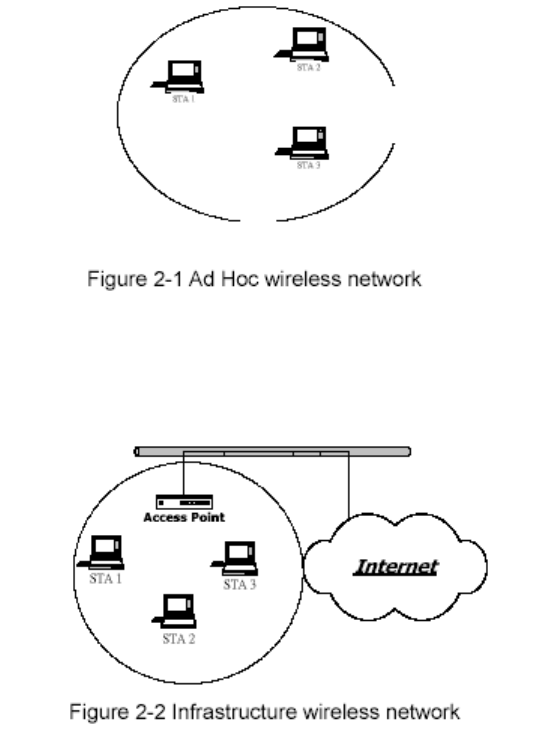
6
• Internal encryption/decryption engine executes IEEE 802.11 64-bit and 128-bit
WEP
• 3.3V and 1.8V power supplies needed and 5V tolerant I/Os
2 Wireless LAN basics
Wireless LAN network defined by IEEE 802.11b standard committee could be
Configure as: Ad Hoc wireless LAN or Infrastructure wireless LAN.
Ad Hoc network is a group of notebooks with wireless LAN PC cards, called a BSS
(Basic Service Set). These notebooks use their wireless LAN PC cards to
communicate with each other directly.
The most obvious differentiation between Infrastructure wireless network and
Ad Hoc wireless network is that the notebooks in Infrastructure wireless network
can make use of the resource in the Internet through Access Point.
To set up your notebook’s network as the type of “Ad Hoc” or “Infrastructure”
wireless network depends completely on your requirement. Generally, if your network
environment has an Access Point, it’s recommend that you set it as “Infrastructure”
mode to connect to the Internet.
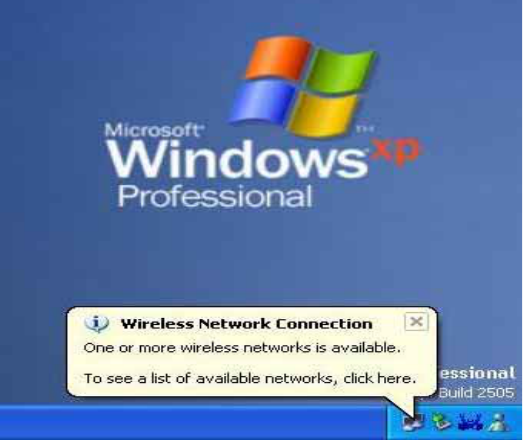
7
3 Configuration Utility.
If you use Windows XP, there are two different utility to configure you wireless setting,
although we provide another more user friendly interface, but both of them are similar in
functional using. You can choose any one of them, that you more like or convenience to use.
3.1 Windows XP Wireless Network Connection Setting.
1. After finished install driver and utility in your system. Next step we can start to setup your
wireless card. First of all we can see the connection notice in the right corner (Fig. 3.1-1)
Fig. 3.1-1
2. Click the notice frame and it will be popup a setup dialog as below (Fig. 3.1-2).
If there have efficient access point, which efficient range contains your pc card range, then
the SSID will appear in the “Available networks” list. Select one and click Connect button.
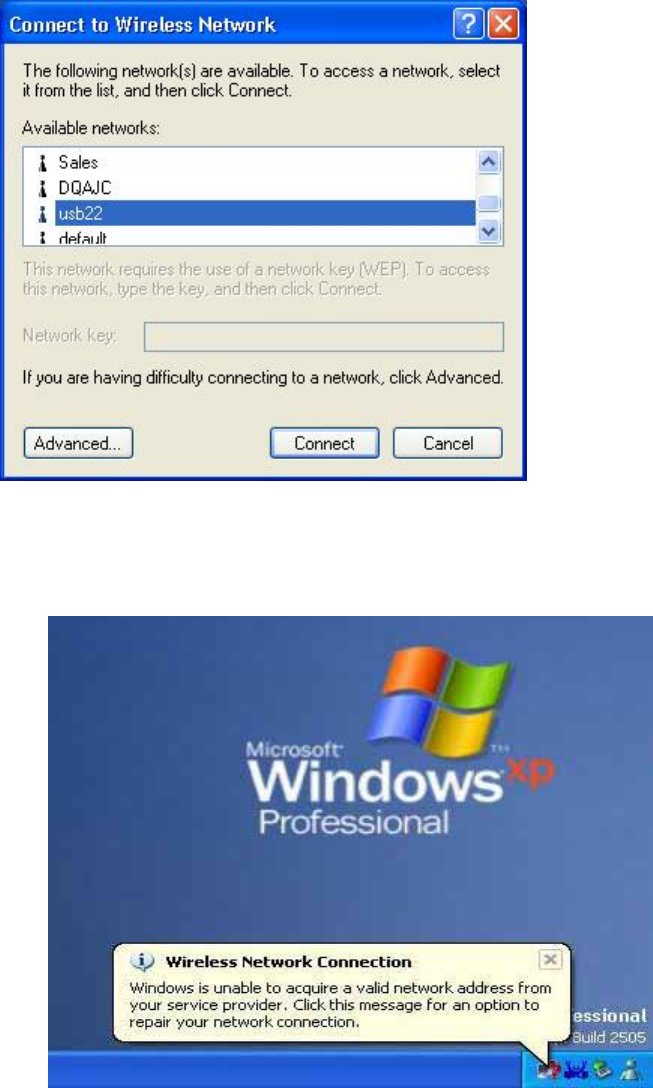
8
Fig. 3.1-2
3. It’s normal sight when you pick a good connection. Windows XP will appear warning
notice as following (Fig. 3.1-3) for a second.
Fig. 3.1-3
4. After several seconds, you will see connection states information on notice frame (Fig.3.1-4).
It will show SSID and signal strength.
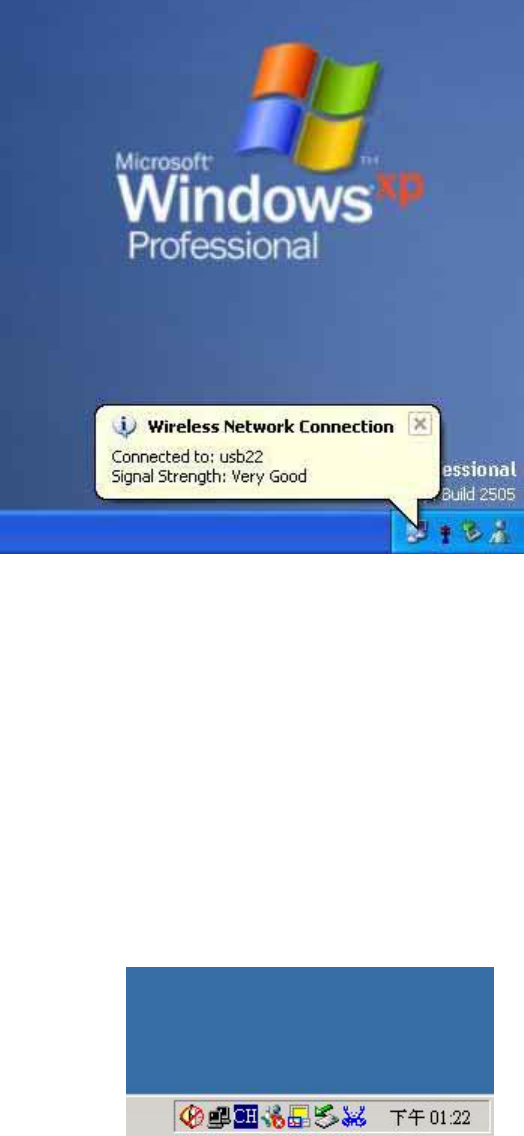
9
Fig.3.1-4
3.1 Realtek Connection Setting.
We provide another wireless setting utility for Windows (2000/me/98SE) use. Of course,
Windows XP version already prepared. Every function is the same like Windows 2k version.
1. Plug-in wireless card and you will see Realtek utility appear on your system tray.
(Fig3.2-1)
(Fig3.2-1)
2. Double-click the crab icon, following dialog box will appear. (Fig3.2-2)
Wait a second till the blank list available wireless networks, if the net require WEP key, just
input correct WEP key into Network key field and confirm again, click Connect button to
build valid connection.
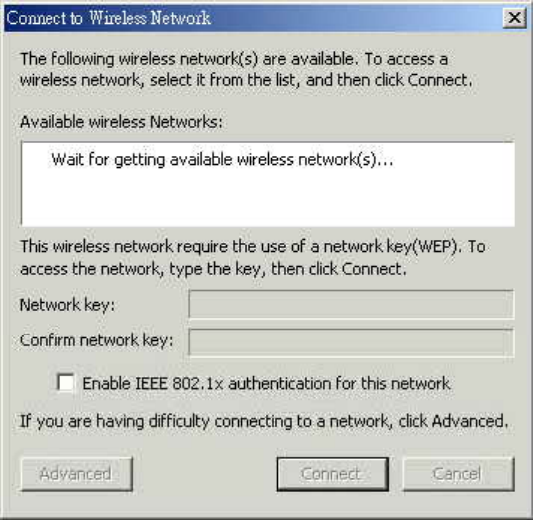
10
(Fig3.2-2)
3.Trending towards advanced setting, we can click “Advanced” button at beginning, a
new window will pop-up as following. (Fig3.2-3) You can assign Access Point which you want
connect to. We also can change presently connection just click SSID from “Available
Profile” list then click remove button to end off connection. At the bottom of window, it will
show presently signal strength and link quality clearly. It can help us to select which Access
Point owned the best link quality when we set our connection. If we always use some fixed
profile, you can set it be a default to avoid the trouble, which you need set profile when you
login network.
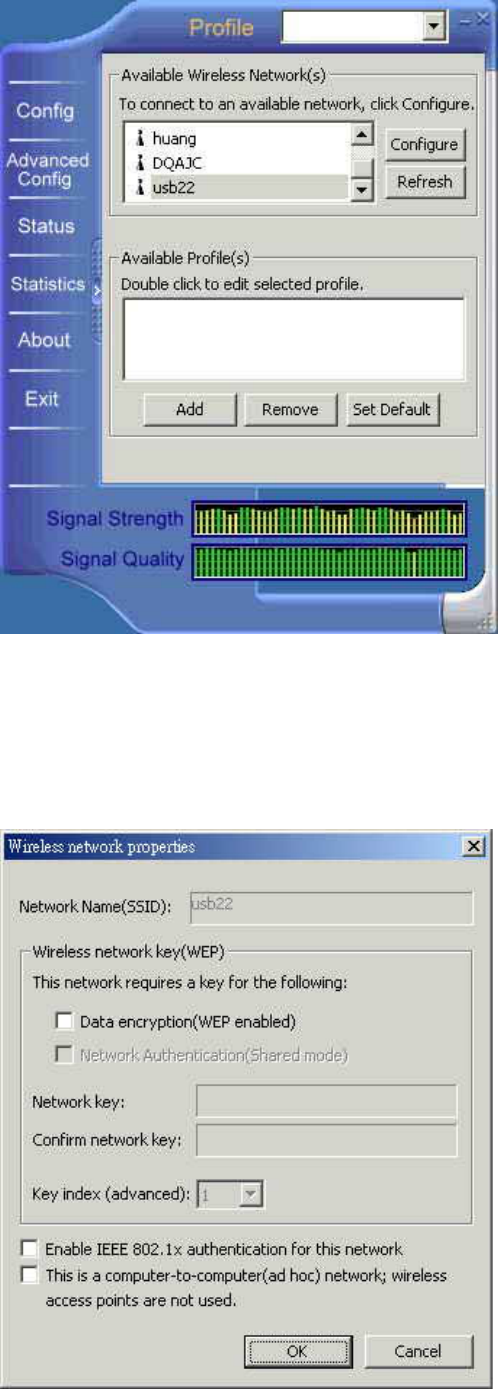
11
(Fig3.2-3)
4.There are several wireless network coexist, we must consider with data Encryption. It
depend on your Access Point security setting, one of them not match , them the connection
will be failed.
4 Technical Specifications of WLAN PC Card

12
Product Name WLAN CardBus
Standard IEEE802.11b
Frequency Band 2.400GHz ~2.4835GHz
Spread Spectrum DSSS (Direct Sequence Spread Spectrum)
Modulation Method DQPSK/DBPSK/CCK
Data Rate 1Mbps, 2Mbps, 5.5Mbps, 11Mbps
Operation Mode Ad hoc Infrastructure(Need Access Point).
Antenna Diversity Patch Antenna
Power Consumption
Tx Typical : 380mA
Rx Typical: 145mA
Sleep Mode: 25mA
Security 64-bit or 128-bit WEP (Wired Equivalent Privacy)
Management Windows-based utility for configuration and status monitoring.
Operating system supported. Windows 98SE、 ME、2000、XP and Linux.
Regulation FCC part 15 for North America. CE/ETSI for European.
I/O Interface 32-bit Cardbus.
Sensitivity –84dBm at < 8% BER
RF Output Power 16dBm (Typical)
LED indicator Red LED: Active
Dimension 118.5(L) x 54(W) x 5(H) mm
Weight 37.5gram
Input Power 3.3 or 5V DC
Operating Temperature 0~55℃(operation)
Storage Temperature -10 ~ 70℃
Humidity 5~90%(non-condensing)
Operating Range Up to 300 m (depending on surrounding environment)
5 Glossary
IEEE 802.11 Standard
The IEEE 802.11 Wireless LAN standards subcommittee, which is formulating a
standard for the industry.
Access Point
13
An internetworking device that seamlessly connects wired and wireless networks together.
Ad Hoc
An Ad Hoc wireless LAN is a group of computers, each with a WLAN adapter,
connected as an independent wireless LAN. Ad Hoc wireless LAN is applicable at a
departmental scale for a branch or SOHO operation.
BSSID
A specific Ad Hoc LAN is called a Basic Service Set (BSS). Computers in a BSS must
be configured with the same BSSID.
DHCP
Dynamic Host Configuration Protocol - a method in which IP addresses are assigned
by server dynamically to clients on the network. DHCP is used for Dynamic IP
Addressing and requires a dedicated DHCP server on the network.
Direct Sequence Spread Spectrum
This is the method the wireless cards use to transmit data over the frequency
spectrum. The other method is frequency hopping. Direct sequence spreads the data
over one frequency range (channel) while frequency hopping jumps from one narrow
frequency band to another many times per second.
ESSID
An Infrastructure configuration could also support roaming capability for mobile
workers. More than one BSS can be configured as an Extended Service Set (ESS).
Users within an ESS could roam freely between BSSs while served as a continuous
connection to the network wireless stations and Access Points within an ESS must be
configured with the same ESSID and the same radio channel.
Ethernet
Ethernet is a 10/100Mbps network that runs over dedicated home/office wiring. Users
must be wired to the network at all times to gain access.
Gateway
A gateway is a hardware and software device that connects two dissimilar systems,
such as a LAN and a mainframe. In Internet terminology, a gateway is another name
for a router. Generally a gateway is used as a funnel for all traffic to the Internet.
IEEE
Institute of Electrical and Electronics Engineers
14
Infrastructure
An integrated wireless and wired LAN is called an Infrastructure configuration.
Infrastructure is applicable to enterprise scale for wireless access to central database,
or wireless application for mobile workers.
ISM Band
The FCC and their counterparts outside of the U.S. have set aside bandwidth for
unlicensed use in the so-called ISM (Industrial, Scientific and Medical) band.
Spectrum in the vicinity of 2.4 GHz, in particular, is being made available worldwide.
This presents a truly revolutionary opportunity to place convenient high-speed
wireless capabilities in the hands of users around the globe.
Local Area Network (LAN)
A LAN is a group of computers, each equipped with the appropriate network adapter
card connected by cable/air, that share applications, data, and peripherals. All
connections are made via cable or wireless media, but a LAN does not use telephone
services. It typically spans a single building or campus.
Network
A network is a system of computers that is connected. Data, files, and messages can
be transmitted over this network. Networks may be local or wide area networks.
PCMCIA
Personal Computer Memory Card International Association. Also a PCMCIA card is
also referred to PC Card.
Protocol
A protocol is a standardized set of rules that specify how a conversation is to take
place, including the format, timing, sequencing and/ or error checking.
SSID
A Network ID unique to a network. Only clients and Access Points that share the same SSID
are able to communicate with each other. This string is case-sensitive.
Simple Network Management Protocol (SNMP)
Simple Network Management Protocol is the network management protocol of TCP/IP. In
SNMP, agents-which can be hardware as well as software-monitor the activity in the various
devices on the network and report to the network console workstation. Control information
15
about each device is maintained in a structure known as a management information block.
Static IP Addressing
A method of assigning IP addresses to clients on the network. In networks with Static
IP address, the network administrator manually assigns an IP address to each computer. Once
a Static IP address is assigned, a computer uses the same IP address every time it reboots and
logs on to the network, unless it is manually changed.
Transmission Control Protocol / Internet Protocol (TCP/IP)
TCP/IP is the protocol suite developed by the Advanced Research Projects Agency (ARPA).
It is widely used in corporate Internet works, because of its superior design for WANs. TCP
governs how packet is sequenced for transmission the network. The term “TCP/IP” is often
used generically to refer to the entire suite of related protocols.
Transmit / Receive
The wireless throughput in Bytes per second averaged over two seconds.
Wide Area Network (WAN)
A WAN consists of multiple LANs that are tied together via telephone services and / or fiber
optic cabling. WANs may span a city, a state, a country, or even the world.
Copyright Statement
No part of this publication may be reproduced. Stored